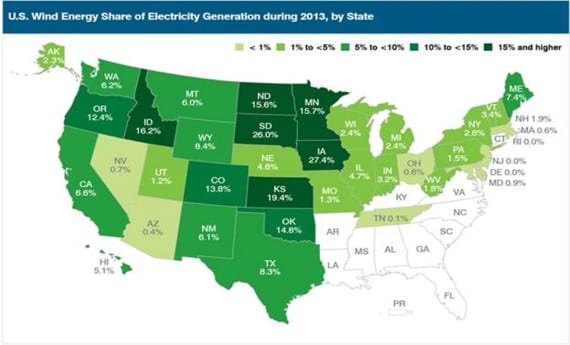The American Wind Energy Association released a new report on Thursday which concludes that adding wind power to the US electricity grid can help the country cut carbon pollution while still keeping the lights on.
“Americans want energy security, clean air, and a more reliable energy system,” said American Wind Energy Association (AWEA) CEO Tom Kiernan. “Diversifying our energy mix with wind helps us achieve all of these goals at once.”
The report, “Wind energy helps build a more reliable and balanced electricity portfolio,” answers 15 of the most frequently asked questions, basing answers upon lessons learned from grid operators’ experiences successfully and reliably integrating wind energy into the existing grid. The study also relies upon dozens of previous studies by grid operators in an attempt to examine how higher levels of wind can be integrated into the US energy mix.
“Based on grid operators’ experience with reliably and cost-effectively integrating very large amounts of wind energy, wind can play can play a key role in meeting EPA’s Clean Power Plan,” said AWEA Senior Director of Research Michael Goggin.
Variable But Stable
One of the fundamental conclusions laid forth in this AWEA report is that the previous assumptions that wind energy is highly variable and, therefore, unstable, are untrue. Rather, according to the report’s authors, “the opposite is actually true at the grid operator scale.” Continuing in the press release which accompanied the report, the AWEA highlight wind energy’s continued growth to becoming an ever-larger share of the electricity mix as the reason for this counter-intuitive stability, stating that “wind turbine technology has matured so that modern wind plants are able to provide the same grid reliability services as conventional generators.”
The second question answered by the report — “How do grid operators accommodate such large amounts of wind energy?” — makes it clear that “variability and uncertainty are nothing new for grid operators, as they have always dealt with large and unexpected fluctuations in electricity supply and demand by changing the output of power plants.”
Furthermore, the majority of changes in wind energy output are cancelled out by other factors in electricity supply and demand, and in those instances where these fluctuations are not covered by other factors, “the same flexible reserves that grid operators have always used” are put into play.
Because wind plant output changes are not correlated across large areas, output changes cancel each other out
Other highlights of the report include:
- Iowa and South Dakota reliably produce more than 25 percent of their electricity from wind power; nine states produce more than 12 percent and more than 4 percent in the US overall.
- Technological advances have enabled US wind farms to set generation records asa percent of demand over the past two years, all without reliability problems:
- At times more than 60 percent on Xcel Energy’s Colorado power system;
- Nearly 40 percent of generation in ERCOT, the main Texas power system; and
- 33 percent in the Southwest Power Pool (area that covers all or parts of several states in the Southwest
- The largest grid operator in the US, PJM, recently reported it could reach 30 percent of wind power while maintaining electricity reliability.
- Ireland, Spain, and Portugal obtaining around 20 percent of their electricity from wind on an annual basis, Denmark at nearly 35 percent, and Germany at 25 percent from wind and solar.
- More than a dozen wind integration studies by US grid operators and others find wind energy can reliably supply at least 20-30 percent of US electricity demands; some studies showing 40 percent.
- Wind power saved consumers $1 billion over just two days across the Great Lakes and Mid-Atlantic states during the 2014 “Polar Vortex” event.
- The current US wind fleet will reduce CO2 emissions by 150 million short tons per year, the equivalent of reducing power sector emissions by more than 5 percent, or 28 million cars worth of carbon emissions.
- There’s enough wind power installed to provide electricity for the equivalent of 18 million American homes.
Policy Certainty Is Vital
Wind power has already met the Environmental Protection Agency’s (EPA) 2020 target for wind, and according to the AWEA, it is well on its way to greatly exceeding the EPA’s 2020-2030 targets. However, wind energy requires policy certainty so that the industry “can continue rapidly scaling up” its levels.
The renewable energy Production Tax Credit has successfully helped the US become the number one wind energy producer in the world. Congress must rapidly extend the PTC for the longest possible time to avoid pushing American wind power off a cliff. A loss of $23 billion to our economy and nearly 30,000 well-paying jobs resulted the last time wind was left without policy stability.
The report’s authors are clear on the fact that “wind and the production tax credit are compatible with well-functioning electricity markets,” adding that the wind industry’s “impact on other generators is market-driven and the same as that of any low-cost generator, and trivially small compared to other factors.”
—
The full report is available from the AWEA’s website.
Source: CleanTechnica. Reproduced with permission.













